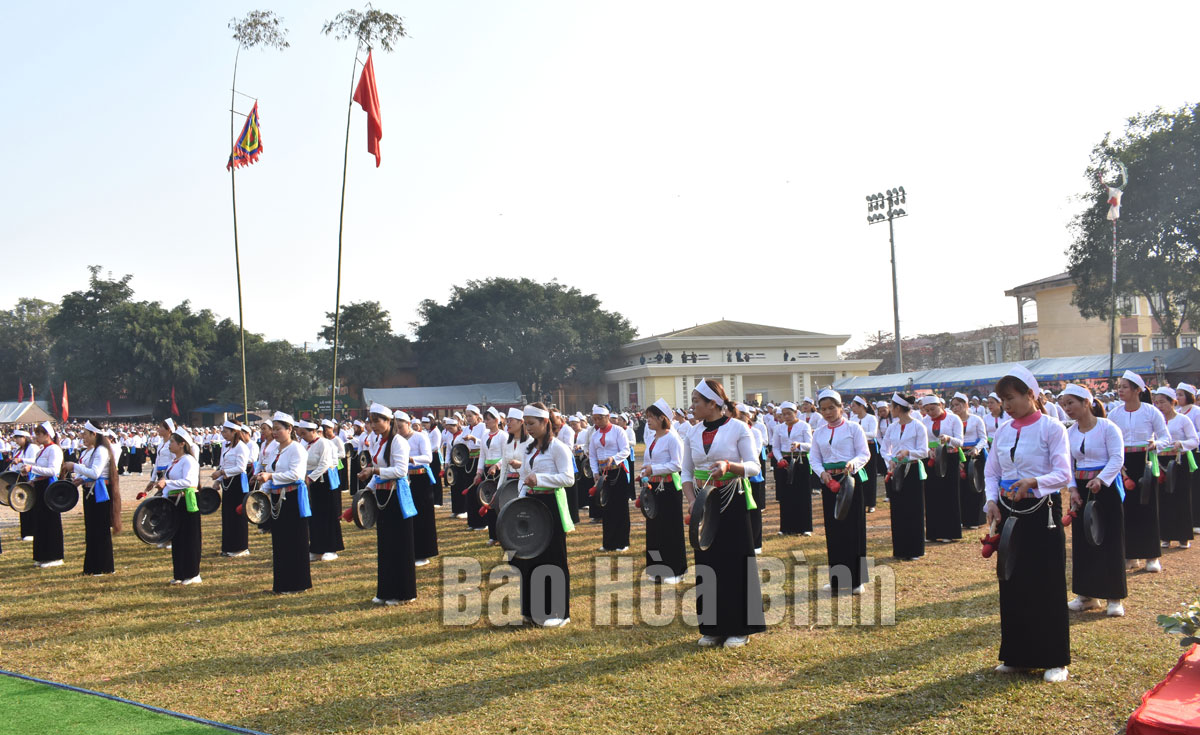
(HBO) - The Muong ethnic group in the northern province of Hoa Binh has over 40 major festivals yearly, and gongs are used in up to 90% of the festivals. For the Muong people in Hoa Binh, gongs are not only a kind of traditional musical instrument, but also a "sacred treasure", a spiritual story told by 12 national tones and an intangible cultural heritage with a strong vitality as they are preserved by the community.

500 Muong ethnic artisans and women perform
the gong in the Muong Ethnic Group Festival in 2023.
Muong Vang people in Lac Son district in particular and the Muong people in Hoa
Binh in general consider gongs as sacred objects, not merely musical
instruments. The sound of gongs is the soul of their culture, echoing the three
levels of the heavens, reaching the after-death world. The sound of gongs is
spiritually calling the Muong people’s ancestors. The Muong people have
absorbed that sound from the womb. When they die, the sound of gongs tells them
the way. Muong people believe that each gong has a spirit and a soul, so it is
a "sacred treasure" with profound spiritual values.
In the house of artisan Bui Ngoc Thuan, of Bung 1 hamlet, Thu Phong commune,
Cao Phong district, a set of Muong gongs is put in the most precious
place. Thuan usually uses his
gongs to teach the next generations. He said that everyone born as a Muong must know how to play Muong gongs.
At present, every commune in Cao Phong district has a Muong gong performance
team. The teams practice
traditional gongs so that they can perform at celebrations, traditional
festivals, and cultural exchanges. Old people teach young people, parents teach
their children, and senior teach beginners. In that way, the old generation
passes it on to the younger ones, and the gongs are kept in the
community.
Cao Phong district
boasts about 3,000 gongs. Hop Phong and Dung Phong are the two communes with
the largest number of gongs.
Meanwhile, Hoa Binh province still keeps more than 11,000 gongs, mostly in
the four districts of Lac Son, Tan Lac, Kim Boi, and Cao Phong, and Hoa Binh
city. To preserve a top typical cultural treasure of the Muong people in Hoa Binh,
the teaching of Muong gongs has been given much care. The province’s Department of Education and Training has actively cooperated
with the localities to have gongs lessons at schools.
The Women's Unions and Youth Unions at the grassroots level also hold classes
to teach Muong gongs. Every year, the province opens dozens of gong classes for
hamlets/communes musical groups.
Up to now, hundreds of clubs have been established across the province to
preserve and promote the values of Muong gongs. Muong gong performances have by now become an indispensable part of festivals
and celebrations in the province./.
The People’s Committee of Lac Son district held a ceremony on April 28 to receive the provincial relic certificate for the ancient rock carving site at Suoi Co stream, located in My Thanh commune.
A special music show titled "The country is in the fullness of joy” has been held at Hoa Binh Square in Hoa Binh city in celebration of the 50th anniversary of the liberation of the South and national reunification (April 30, 1975–2025).
The People's Committee of Lo Son commune, Tan Lac district, has organised the local annual traditional stream fishing festival on April 19 - 20.
As a land deeply intertwined with human history and Vietnam’s millennia-long journey of nation-building and defence, Hoa Binh is often revered for its epic tales and legends.
Residents of Hoa Binh boast a rich cultural identity, reflected in their unique language, traditional attire, customs, and folk melodies – described as "sweet as honey, clear as a mountain stream.”
Lac Son district’s Vu ban town held the 2025 Truong Kha temple festival on April 12–13 (the 15th–16th days of the third lunar month). Since its revival in 2019, the festival has been organised every three years, preserving valuable intangible heritage while meeting the community’s cultural and spiritual needs.



